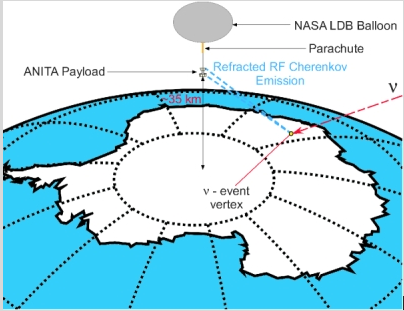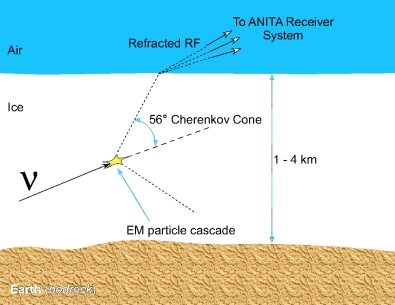Mysterious physics particles or a trick of the ice
- Posted By
10Pointer
- Categories
Science & Technology
- Published
28th May, 2020
-
-
Context
- In a significant breakthrough, a team of researchers have succeeded in finding “a fountain of high-energy particles erupting from the ice" in Antarctica which according to the researchers could be proof of a parallel universe.
- ANITA succeeded in detecting the 'fountain' of high-energy particles in 2006 and 2014 but the researchers initially thought them as background noise or glitches.
-
Background
- Since March 2016, two mysterious signals from Antarctica have baffled researchers.
- Twice now, a high-energy particle has seemed to burst straight up out of the ice, tripping detectors on a balloon-borne experiment floating overhead.
- It's as if the particles had passed through the entire Earth unscathed. But that should be all but impossible: None of the known particles, which collectively are described in a physics model known as the Standard Model, can make that trip at high-energy levels.
- Particles that are otherwise identical can carry different loads of energy, and the amount of energy a particle is carrying can change its behavior.
- Ghostly, low-energy neutrinos can slip through all of the planet’s crust, molten rock and iron unbothered. But they don't pack enough punch to create the signals found in Antarctica.
-
What is ANtarctic Impulsive Transient Antenna or ANITA?
- It is an experiment that is maintained by NASA. It involves an array of radio antennas attached to a helium balloon which flies over the Antarctic ice sheet at 37,000 meters.
- To get a gauge of exactly how high is that, know that commercial flights fly almost a fourth of that height.
- The height is important here to shut out all other "noises" so that the ANITA antennas can "listen" to the cosmos and detect high-energy particles, known as neutrinos, which constantly bombard the planet.
- ANITA is the first NASA observatory for neutrinos of any kind.
- ANITA-I was launched from McMurdo, Antarctica in 2006 and ANITA-II, a modified instrument with 40 antennas, was launched from McMurdo Station in 2008.
- The researchers then launched ANITA-III, which was equipped with systems to improve sensitivity by a factor of 5–10, in December 2014.
- ANITA-IV was launched in December 2016 and it was loaded with tunable notch filters and an improved trigger system.
- According to researchers, ANITA has made four flights of Antarctica continent and managed to detect numerous cosmic rays coming from the sky within the field of view of the experiment.
- These radio waves are created by cosmic ray air showers and they are reflected off the ice before they reach ANITA.

-
What are Neutrinos?
- Neutrinos are high-energy particles that pose no threat to us and pass through most solid objects without anyone even noticing.
- Neutrinos constantly bombard Earth and as per some estimates emerging from studies, 100 trillion neutrinos pass through your body every second!
- Rarely do they interact with matter. But if they do smash into an atom, they produce a shower of secondary particles we can detect, which allows us to probe where they came from in the universe.
- ANITA detects neutrinos pinging in from space and colliding with matter in the Antarctic ice sheet.
- High-energy neutrinos are powerful enough to create the signals. But since these higher-energy neutrinos have larger "cross sections" — they impact a bigger region of surrounding space — they tend to bang into things rather than slip through them.
-
Why Study Neutrinos?
- Neutrinos are of great interest to astrophysicist as they are the only particle that can reach earth unattenuated at all energies.
- This is particularly of interest at high energies where other particles and photons will interact with the photons of the microwave background making them unable to propagate and survive over long astrophysical distances.
- In other words - if you want to see the ultra-high energy universe, you should view it through the "light" of neutrinos
-
How does ANITA Detect Neutrinos?
- The ANITA instrument detects these ultra-high energy neutrinos by use of the Askaryan effect.
- This effect predicts the production of a coherent radio emission from the cascade of particles produced in a high-energy particle interaction.
- In other words they detect a 'snap' in the radio frequencies caused by the interaction of ultra-high energy neutrino.
- In order to detect this radio emission (Askaryan pulses) we need a radio transparent medium for the interaction to occur in - and lots of it since these interactions are rare.
- Some materials that are radio transparent are salt, sand and ice. We also need a fairly radio quiet area as the Askaryan pulses are very faint signals.

-
What has ANITA found?
- Over the years, ANITA has detected a handful of "anomalous" events. Instead of the high-energy neutrinos streaming in from space, they seem to have come from a strange angle, through the Earth's interior, before hitting the detector. These findings can't be explained by our current understanding of physics -- that much is true.
- As per the papers published by The Astrophysical Journal (Cornell University): "During the first three flights of the Antarctic Impulsive Transient Antenna (ANITA) experiment, the collaboration detected several neutrino candidates.
- Two of these candidate events were consistent with an ultra-high-energy up-going air shower and compatible with a tau neutrino interpretation.
- A third neutrino candidate event was detected in a search for Askaryan radiation in the Antarctic ice, although it is also consistent with the background expectation."
- When ANITA reported signals that looked like extremely high-energy neutrinos, physicists were puzzled. These neutrinos had arrived at an angle that suggested they had just travelled through most of the planet, which is not expected for neutrinos at these energies."

